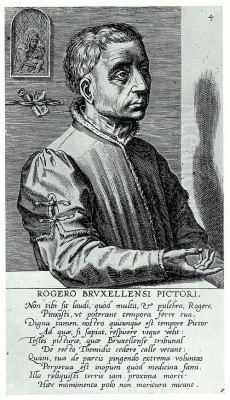
Rogier van der Weyden stands as one of the towering figures of the Northern Renaissance, an artist whose work redefined emotional expression and technical refinement in Early Netherlandish painting during the 15th century. Active primarily in Tournai and Brussels, his influence radiated across Europe, shaping the course of art for generations. Alongside contemporaries like Jan van Eyck and his own master, Robert Campin, Van der Weyden forged a path that blended meticulous realism with profound psychological depth, leaving behind a legacy of powerful religious narratives and penetrating portraits. His ability to convey human suffering, piety, and dignity remains striking even centuries later.
Born Rogier de le Pasture around 1399 or 1400 in Tournai, then part of the Burgundian Netherlands (now Belgium), he came from a family of artisans; his father, Henri de le Pasture, was a master cutler. His mother was Agnes de Watrelos. The environment of Tournai, a prosperous center for arts and crafts, undoubtedly played a role in his early development. While details of his earliest training remain somewhat obscure, historical records provide a clearer picture from his late twenties onwards.
Early Training and Apprenticeship
A pivotal moment in Van der Weyden's formation was his apprenticeship under Robert Campin, another leading painter of Tournai, often identified with the anonymous Master of Flémalle. Records indicate that Rogier de le Pasture entered Campin's workshop on March 5, 1427. This was relatively late for an apprenticeship to begin, leading to speculation about his activities prior to this date. Some scholars suggest an earlier, undocumented period of training, possibly even in manuscript illumination or sculpture, given the sculptural quality often seen in his painted figures.
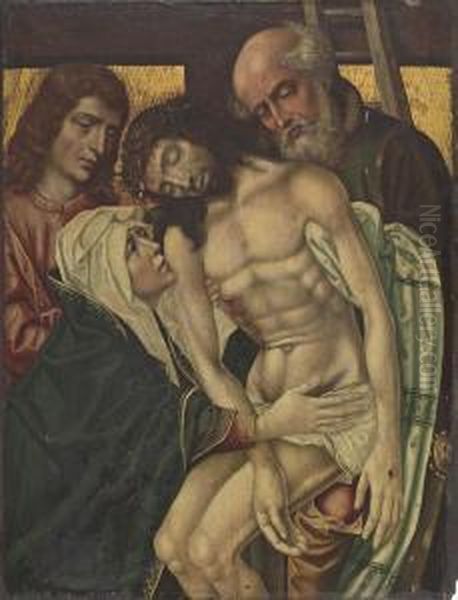
The period spent with Campin, lasting until August 1, 1432, when Rogier was officially recognized as a master painter by the Tournai painters' guild, was crucial. Campin was a pioneer of the new naturalism emerging in the North, emphasizing tangible reality, robust figures, and detailed settings. Van der Weyden absorbed these elements but soon began to infuse them with his own distinct sensibility, particularly a greater emphasis on linear grace, compositional harmony, and, above all, intense emotional resonance. The influence of Jan van Eyck, the other giant of the era, is also discernible, particularly in the sophisticated use of oil paint and the rendering of light and texture, though their artistic temperaments differed significantly.
An intriguing record from 1426 mentions the city of Tournai honouring a certain "Maistre Rogier de le Pasture" with a gift of wine. If this refers to the painter, the title "Master" at this early date is puzzling, as it predates his official guild mastery. It might suggest some form of academic achievement or recognition outside the standard painters' guild structure, but concrete evidence is lacking. Regardless, his formal training under Campin provided the technical foundation upon which he built his remarkable career.
Brussels: The Official City Painter
Around 1435, Rogier van der Weyden made a significant move, relocating from Tournai to Brussels, the burgeoning administrative and cultural heart of the Duchy of Burgundy under Philip the Good. It was likely here that he adopted the Flemish version of his name, "Van der Weyden." His reputation must have preceded him, as shortly after his arrival, possibly by 1436, he was appointed the official Painter of the City of Brussels. This prestigious position brought not only status but also significant commissions, particularly for the city's magnificent Town Hall.
In Brussels, Van der Weyden established a large and highly productive workshop. He married Elisabeth Goffaert, the daughter of a Brussels shoemaker, and they had four children: Cornelius (who became a Carthusian monk), Margaretha, Pieter (who became a painter), and Jan (who became a goldsmith). His success grew rapidly, attracting wealthy patrons from the Burgundian court, the city's elite, foreign merchants, and various religious institutions. His workshop became a major center of artistic production, training assistants and disseminating his style.
His role as city painter involved creating works that reflected the civic pride and judicial values of Brussels. Among the most famous, though tragically lost, were the four large panels depicting Scenes of Justice, painted for the 'Golden Chamber' of the Brussels Town Hall. These works, illustrating the Justice of Trajan and the Justice of Herkenbald, were renowned for their realism and moral force, admired by visitors like Albrecht Dürer centuries later. Unfortunately, they were destroyed during the French bombardment of Brussels in 1695. Only tapestry copies and written descriptions hint at their original grandeur.
The Signature Style: Emotion and Elegance
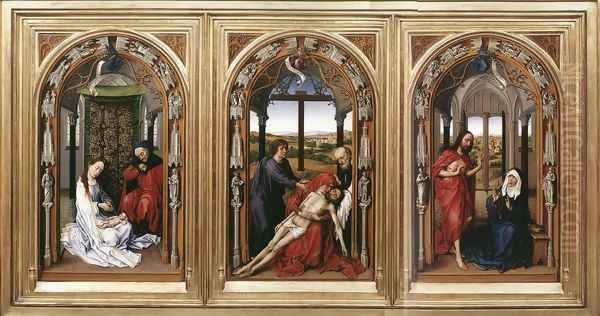
Rogier van der Weyden's art is distinguished by its profound emotional depth, a characteristic that sets him apart even from his talented contemporaries. While Jan van Eyck often focused on serene observation and meticulous detail, Van der Weyden prioritized the dramatic and the pathetic. He excelled at depicting human suffering, piety, and tenderness, using expressive faces, gestures, and dynamic compositions to engage the viewer directly with the emotional core of the subject matter.
His figures, though grounded in realistic observation, possess an aristocratic elegance and linear grace. Drapery is often rendered with sharp, angular folds that convey tension and movement, contributing to the overall emotional impact. Unlike the often cluttered, symbol-laden interiors of Campin or Van Eyck, Van der Weyden frequently simplified his backgrounds or used shallow, stage-like spaces to focus attention intensely on the human drama unfolding in the foreground. This is particularly evident in his devotional works, designed to inspire empathy and contemplation.
Compositionally, Van der Weyden was a master designer. He often employed sophisticated arrangements, using repeating rhythms, balanced masses, and strong diagonal lines to create visual harmony and direct the viewer's eye. His use of color was rich and resonant, often employing deep reds and blues contrasted with pale flesh tones and luminous whites to heighten the emotional key. Light in his paintings is typically clear and cool, modeling forms precisely and contributing to the clarity of the narrative.
Masterpieces of Religious Art
Van der Weyden's reputation rests heavily on his powerful religious paintings, particularly his altarpieces and devotional panels. Among the most celebrated is The Descent from the Cross, likely painted around 1435, possibly commissioned by the Leuven Crossbowmen's Guild (whose symbol appears subtly in the tracery). Now housed in the Museo del Prado, Madrid, this large oak panel is a landmark of Northern European art. It depicts the moment Christ's body is lowered from the cross, concentrating a group of grieving figures within a shallow, box-like space resembling a sculpted shrine.
The emotional intensity of The Descent is overwhelming. The Virgin Mary collapses in a faint, her pose mirroring that of her dead son, creating a powerful visual and emotional parallel. Mary Magdalene and Saint John the Evangelist express profound sorrow through their gestures and tear-streaked faces. Van der Weyden's skill in rendering textures – the richness of the robes, the pallor of Christ's flesh, the glint of tears – enhances the scene's realism and pathos. Despite its historical questioning regarding attribution in earlier centuries, it is now universally accepted as a cornerstone of his oeuvre.
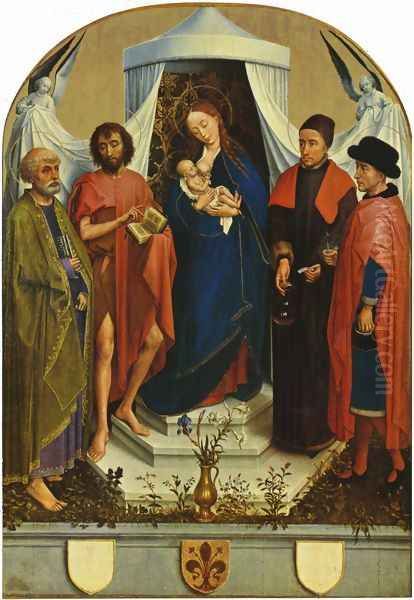
Another major work is The Last Judgment Altarpiece, commissioned by Nicolas Rolin, Chancellor of Burgundy, for the Hôtel-Dieu hospital he founded in Beaune, France (where it remains). This monumental polyptych, painted between 1443 and 1451, depicts Christ enthroned as judge, flanked by saints and apostles, with the Archangel Michael weighing souls below. The outer panels show the donors kneeling in prayer. The depiction of the damned being dragged into hell is particularly harrowing, showcasing Van der Weyden's ability to visualize complex theological concepts with dramatic force.
Other significant religious works include the Miraflores Altarpiece (c. 1442-45), the Saint John Altarpiece (c. 1455-60), and The Seven Sacraments Altarpiece (c. 1445-50). These multi-panel works explore key moments in the lives of Christ and the Virgin Mary, demonstrating his narrative skill and consistent emotional depth. Smaller devotional panels, such as diptychs featuring the Virgin and Child paired with a praying donor, like the Diptych of Philippe de Croÿ, were also a significant part of his output, catering to the private piety of his patrons. The Medici Madonna, likely commissioned by the prominent Florentine family, shows his engagement with Italian patrons.
Penetrating Portraits
Beyond religious subjects, Rogier van der Weyden was a highly sought-after portraitist. His portraits are characterized by their sharp psychological insight, refined elegance, and meticulous rendering of detail, capturing both the likeness and the social standing of the sitter. He often depicted his subjects in three-quarter view, set against a plain, dark background, which focuses attention entirely on the face and hands.
His sitters often appear reserved and introspective, yet Van der Weyden subtly conveys their personality through the set of the mouth, the gaze of the eyes, and the delicate modeling of features. Hands are often prominently featured and beautifully rendered, sometimes holding attributes related to the sitter's identity or status. Examples include the sensitive Portrait of a Lady (c. 1460, National Gallery of Art, Washington D.C.), notable for its depiction of quiet piety and intricate headdress, and the Portrait of Francesco d'Este (c. 1460, Metropolitan Museum of Art, New York), which captures the alert intelligence of the Italian nobleman.
He also painted members of the Burgundian court, including Duke Philip the Good himself, although the surviving portraits are often considered workshop versions based on a lost original. A portrait identified as Charles the Bold, Philip's son and successor, also exists, showcasing the artist's connection to the highest levels of society. These portraits established a standard for aristocratic representation that influenced portrait painting across Northern Europe.
Influence and Workshop Practice
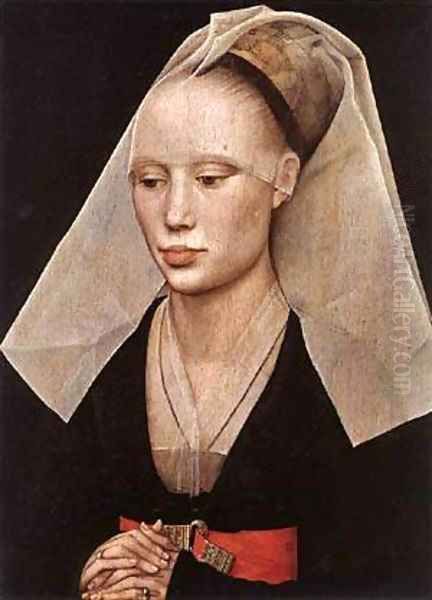
Rogier van der Weyden's influence during his lifetime and in the decades following his death was immense, arguably surpassing even that of Jan van Eyck in terms of immediate impact across Europe. His workshop in Brussels was large and busy, employing numerous assistants and apprentices to help meet the demand for his work. Distinguishing the master's hand from that of his collaborators in many surviving paintings remains a challenge for art historians.
His clearly defined compositions, expressive figures, and emotionally charged narratives were readily adaptable and highly appealing. Artists in the Netherlands, France, Germany, and Spain eagerly imitated his style. Among his most direct followers was Hans Memling, who may have spent time in Van der Weyden's workshop before establishing himself in Bruges. Memling adopted Rogier's compositional models and elegant figure types but softened the emotional intensity, creating works of serene beauty.
Other major Netherlandish painters clearly indebted to Van der Weyden include Dieric Bouts, Petrus Christus, and Hugo van der Goes. Bouts, active in Leuven, adapted Rogier's compositional clarity and solemnity, while Christus, working in Bruges, combined elements from both Van Eyck and Van der Weyden. Van der Goes, known for his own intense emotionalism, pushed Rogier's pathos in new directions. The German engraver Martin Schongauer played a crucial role in disseminating Van der Weyden's compositions more widely through prints, influencing artists far beyond the reach of the original paintings.
A documented trip to Rome for the Jubilee Year of 1450 exposed Van der Weyden to Italian art. While direct evidence of specific encounters is scarce, he was reportedly admired by Italian humanists like Cyriacus of Ancona and Bartolomeo Facio. He likely saw works by leading Italian artists such as Fra Angelico and Benozzo Gozzoli. While his fundamental style remained Northern, some scholars detect subtle reflections of Italian art, perhaps in compositional structures or figure types, in his later works. Conversely, his own work likely influenced Italian painters who saw it either during his visit or through imported examples.
Legacy and Rediscovery
Rogier van der Weyden died on June 18, 1464, in Brussels and was buried in the Church of St. Gudula (now the Cathedral of St. Michael and St. Gudula). He was a wealthy and highly respected figure at the time of his death. His influence continued strongly through the late 15th century, but by the 17th century, his fame began to be eclipsed, particularly by the enduring reputation of Jan van Eyck. Changing tastes and the loss of key works like the Justice panels contributed to this relative decline.
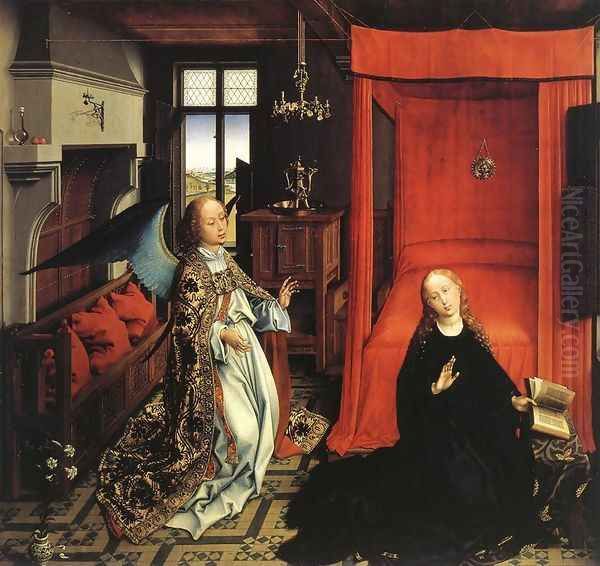
However, the 19th and early 20th centuries witnessed a resurgence of interest in Early Netherlandish painting, and Van der Weyden's crucial role was re-evaluated and fully recognized. Art historians meticulously reconstructed his oeuvre, distinguishing his work from that of his workshop and followers, and analyzing his unique contributions. Today, he is firmly established as one of the three most important figures (alongside Van Eyck and Campin) of the first generation of Early Netherlandish masters.
His legacy lies in his extraordinary ability to synthesize the burgeoning realism of his time with profound human emotion. He created images of sorrow, piety, and dignity that resonated deeply with the religious sensibilities of the 15th century and continue to move viewers today. His technical mastery of the oil medium, his sophisticated compositional skills, and his influential approach to both religious narrative and portraiture secure his place as a pivotal artist in the history of Western art. His work remains a benchmark for the expressive potential of painting in the Northern Renaissance.